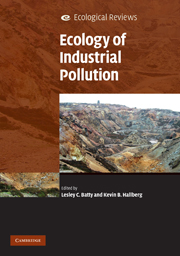Book contents
- Frontmatter
- Contents
- List of contributors
- Preface
- Acknowledgements
- 1 Consequences of living in an industrial world
- 2 Metallophytes: the unique biological resource, its ecology and conservational status in Europe, central Africa and Latin America
- 3 Lichens and industrial pollution
- 4 The impacts of metalliferous drainage on aquatic communities in streams and rivers
- 5 Impacts of emerging contaminants on the environment
- 6 Ecological monitoring and assessment of pollution in rivers
- 7 Detecting ecological effects of pollutants in the aquatic environment
- 8 With the benefit of hindsight: the utility of palaeoecology in wetland condition assessment and identification of restoration targets
- 9 An ecological risk assessment framework for assessing risks from contaminated land in England and Wales
- 10 Diversity and evolution of micro-organisms and pathways for the degradation of environmental contaminants: a case study with the s-triazine herbicides
- 11 The microbial ecology of land and water contaminated with radioactive waste: towards the development of bioremediation options for the nuclear industry
- 12 The microbial ecology of remediating industrially contaminated land: sorting out the bugs in the system
- 13 Ecological recovery in a river polluted to its sources: the River Tame in the English Midlands
- 14 Manchester Ship Canal and Salford Quays: industrial legacy and ecological restoration
- 15 Large-scale mine site restoration of Australian eucalypt forests after bauxite mining: soil management and ecosystem development
- 16 Sustaining industrial activity and ecological quality: the potential role of an ecosystem services approach
- Index
- Plate section
- References
5 - Impacts of emerging contaminants on the environment
Published online by Cambridge University Press: 05 June 2012
- Frontmatter
- Contents
- List of contributors
- Preface
- Acknowledgements
- 1 Consequences of living in an industrial world
- 2 Metallophytes: the unique biological resource, its ecology and conservational status in Europe, central Africa and Latin America
- 3 Lichens and industrial pollution
- 4 The impacts of metalliferous drainage on aquatic communities in streams and rivers
- 5 Impacts of emerging contaminants on the environment
- 6 Ecological monitoring and assessment of pollution in rivers
- 7 Detecting ecological effects of pollutants in the aquatic environment
- 8 With the benefit of hindsight: the utility of palaeoecology in wetland condition assessment and identification of restoration targets
- 9 An ecological risk assessment framework for assessing risks from contaminated land in England and Wales
- 10 Diversity and evolution of micro-organisms and pathways for the degradation of environmental contaminants: a case study with the s-triazine herbicides
- 11 The microbial ecology of land and water contaminated with radioactive waste: towards the development of bioremediation options for the nuclear industry
- 12 The microbial ecology of remediating industrially contaminated land: sorting out the bugs in the system
- 13 Ecological recovery in a river polluted to its sources: the River Tame in the English Midlands
- 14 Manchester Ship Canal and Salford Quays: industrial legacy and ecological restoration
- 15 Large-scale mine site restoration of Australian eucalypt forests after bauxite mining: soil management and ecosystem development
- 16 Sustaining industrial activity and ecological quality: the potential role of an ecosystem services approach
- Index
- Plate section
- References
Summary
Introduction
Until very recently, the main focus on chemicals in the environment has been on heavy metals, pesticides and other organic chemicals such as PAHs, PCBs and dioxins. In recent years, there has been increasing concern over the so-called ‘emerging contaminants’ such as metabolites, transformation products (formed in the environment and treatment processes), human pharmaceuticals, veterinary medicines, nanomaterials, personal care products and flame retardants. These substances have been shown to be released to the environment, or in the case of nanomaterials, will be released to the environment in increasing amounts in the future. In the few monitoring studies that have looked for them, they have been detected in surface waters, groundwaters and drinking waters (e.g., Kolpin et al.1998a, b; 2002; Ferrer et al. 2000; Juhler et al. 2001; Li et al. 2001; Schnoebelen et al. 2001; Lagana et al. 2002; Zimmerman et al. 2002; Battaglin et al. 2003).
Alongside the monitoring, studies have been performed to explore the effects of a range of emerging contaminants at the biochemical, cellular, whole organism, population and community levels. While much of the data that have been produced on different classes of emerging contaminants indicate that many pose a small risk to ecosystems and human health, there is some evidence that selected emerging contaminants could affect human and environmental health.
- Type
- Chapter
- Information
- Ecology of Industrial Pollution , pp. 101 - 125Publisher: Cambridge University PressPrint publication year: 2010
References
- 2
- Cited by



